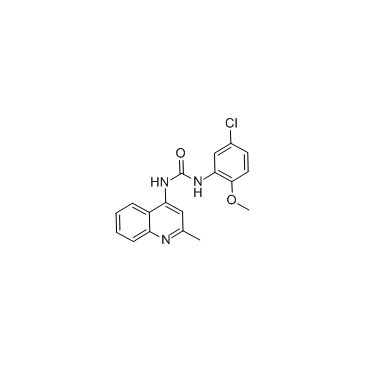196868-63-0
| Name | 1-(5-chloro-2-methoxyphenyl)-3-(2-methylquinolin-4-yl)urea |
|---|---|
| Synonyms |
1-(5-Chloro-2-methoxyphenyl)-3-(2-methyl-4-quinolinyl)urea
IGF-1R Inhibitor II UNII-2N3LV83S8J 1-(5-Chloro-2-methoxyphenyl)-3-(2-methylquinolin-4-yl)urea TCMDC-125497 N-(5-chloro-2-methoxyphenyl)-N'-(2-methyl-4-quinolinyl) Urea, N-(5-chloro-2-methoxyphenyl)-N'-(2-methyl-4-quinolinyl)- PQ 401 PQ401 |
| Description | PQ401, a selective insulin-like growth factor-1 receptor blocker, is a novel diarylurea compound that inhibits IGF1R autophosphorylation with IC50 < 1 uM.IC50 Value: 12 uM (inhibited autophosphorylation of the IGF-IR in cultured human MCF-7 cells) [1]Target: IGF1Rin vitro: PQ401 inhibited autophosphorylation of the IGF-IR in cultured human MCF-7 cells with an IC50 of 12 micromol/L and autophosphorylation of the isolated kinase domain of the IGF-IR with an IC50 <1 micromol/L. In addition,PQ401 inhibited the growth of cultured breast cancer cells in serum at 10 micromol/L. PQ401 was even more effective at inhibiting IGF-I-stimulated growth of MCF-7 cells (IC50, 6 micromol/L) [1]. Twenty-four hours of treatment with 15 micromol/L PQ401 induced caspase-mediated apoptosis. Pretreatment with PQ401 before IGF-1 (10 ng in 0.5 μl), both administered to the POA 30 min apart, showed significant attenuation of the IGF-1-induced increase in core body temperature (p < 0.05). A similar attenuated hyperthermic response to IGF-1 by PQ401 pretreatment is observed when the temperature of the BAT is measured [3].in vivo: IGF1R inhibition by PQ401 exerted no significant effects on diabetic kidney disease parameters, arguing against a role for IGF-I in the pathogenesis of diabetic kidney disease. However, PQ401 affects normal kidneys, inducing renal hypertrophy as well as collagen and fat accumulation, with increased renal IGF-I mRNA, suggestive of a damage-regeneration process [2].Clinical trial: No Development Reported |
|---|---|
| Related Catalog | |
| References |
| Density | 1.4±0.1 g/cm3 |
|---|---|
| Boiling Point | 426.1±45.0 °C at 760 mmHg |
| Melting Point | 190 °C(dec.) |
| Molecular Formula | C18H16ClN3O2 |
| Molecular Weight | 341.792 |
| Flash Point | 211.5±28.7 °C |
| Exact Mass | 341.093109 |
| PSA | 63.25000 |
| LogP | 5.35 |
| Appearance | white |
| Vapour Pressure | 0.0±1.0 mmHg at 25°C |
| Index of Refraction | 1.709 |
| Storage condition | 2-8°C |
| Water Solubility | DMSO: >10mg/mL |
| Symbol |

GHS06 |
|---|---|
| Signal Word | Danger |
| Hazard Statements | H301 |
| Precautionary Statements | P301 + P310 |
| Personal Protective Equipment | Eyeshields;Faceshields;Gloves;type P2 (EN 143) respirator cartridges |
| Hazard Codes | T: Toxic; |
| Risk Phrases | R25 |
| Safety Phrases | S45 |
| RIDADR | UN 2811 6.1/PG 3 |
| HS Code | 2933499090 |
| HS Code | 2933499090 |
|---|---|
| Summary | 2933499090. other compounds containing in the structure a quinoline or isoquinoline ring-system (whether or not hydrogenated), not further fused. VAT:17.0%. Tax rebate rate:13.0%. . MFN tariff:6.5%. General tariff:20.0% |
